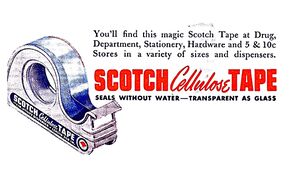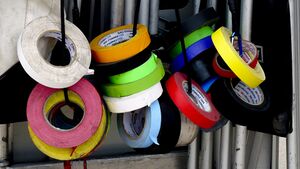Sticking With It
Gaffer is a very tough adhesive fabric tape with that can be removed without leaving a residue. Widely used in the theatre, live event, film and broadcast industries, it was invented in the USA in 1959 by Ross Lowell.
The origins of adhesive tape lie in Hamburg, Germany. The Merkur Pharmacy in Hamburg was taken over by the pharmacist Paul Carl Beiersdorf in 1880. There he worked to develop a quick wound dressing. In 1882, he finally developed the wound plaster from the latex derived from the gutta-percha tree, and from gauze soaked in hot ointments. He applied for a patent and concentrated completely on the production of the plaster but without success. The plaster held well, but critics claimed that the skin tore off when the plaster was removed. A few years later, the field of application of the highly adhesive plaster was redefined. It was now intended to seal punctured bicycle tyres and thus became the world's first technical adhesive tape.
20 years later in Detroit the US company 3M was manufacturing abrasive paper. While testing a new product in an automobile production plant in 1923, 3M employees learned of problems with the two-colour paint process, which was new but popular at the time. Manufacturers lacked a suitable way of masking finished paintwork while applying the second colour, to ensure a clean join. In 1925 Richard G. Drew presented a 5cm wide crepe strip with a thin layer of adhesive around the edges. The crepe strip failed the test because it did not stick, so the painter raged, ‘Take this tape back to those Scotch bosses of yours and tell them to put more adhesive on it!’. In the vernacular of the time, the word ‘Scotch’ was a pejorative insult because Scots had a reputation in the early 20th century for being overly thrifty and ‘stingy’. As a result, Drew coated the masking tape completely with adhesive. The first crepe tape was thus invented. The engineer remembered the painter’s angry words and named the tape ‘Scotch Masking Tape’. Due to the outstanding success of the masking tape, the company focused on the development of new adhesive products. In 1930, it invented the world’s first transparent adhesive tape. Originally, the tape was used mainly by bakeries, butchers and food retailers to seal their cellophane packaging. But due to the economic depression, it became an unexpected success: the population, forced to economise, used the tape for small repair jobs.
Gaffer tape (Q4334) was invented in 1959 by Ross Lowell (Q30482) – an American inventor, author, photographer, cinematographer, lighting designer and entrepreneur. In addition to his patented quick-clamp lighting mount system, he saw the need for an adhesive tape that could be used to temporarily stick down cables or attach small pieces of equipment, and then be removed without leaving a residue. Lowell used the adhesive from Johnson & Johnson’s Permacel tape, also known as duct tape, and applied it to silver fabric, so creating gaffer tape. He marketed it through his lighting company, Lowel-Light. The origins of the name are unclear, but the gaffer is chief lighting technician on a film set, so the name may come from ‘gaffer’s tape’.
Today, gaffer tape is available in a wide range of colours from neon yellow to pink and green, in a range from very conspicuous to extremely inconspicuous, and in widths from 6mm to 100mm. To attract as little attention as possible and reflect as little light as possible, the classic gaffer tape is offered in matt black, and this colour, 50mm wide, is probably the most commonly used type.
Gaffer tape is heat-resistant, water-resistant and tear-resistant. With these properties, it is the ideal helper on stage and in the studio - and even beyond! Just laying a cable on the stage floor so that you don’t trip over it? No problem with black gaffer tape. Need a little marker on the floor so you know where to stand in the perfect light? Yes, you can simply use gaffer tape for that too. You can mark everything with it and write on it. You need to fix something to a truss? We've even seen complete spotlights dangling from the aluminium pole with silver gaffer tape – please don't copy it! Gaffer tape is extremely resistant to tearing, but there are proper fasteners for that. By the way, with a short transverse tear you have interrupted the tensile strength in no time and cut off the desired length from the roll – without any annoying scissors!
And for techie Star Wars fans: Q: Why is gaffer tape like the Force? A: Because it is dark on one side, light on the other, and it holds the universe together.



